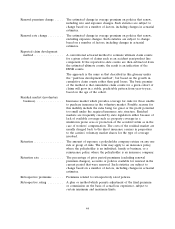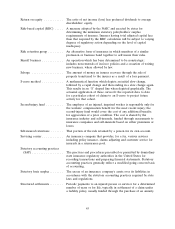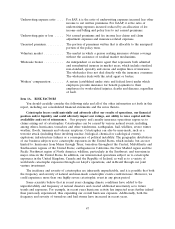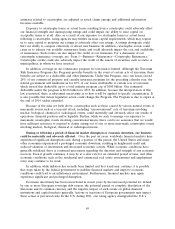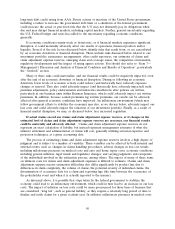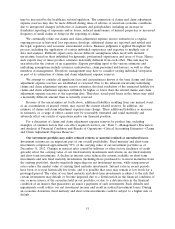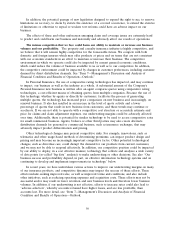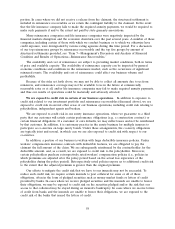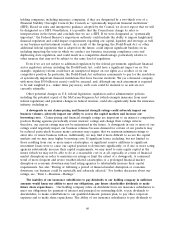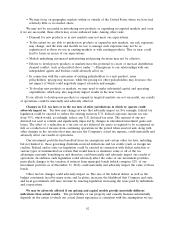Travelers 2012 Annual Report Download - page 64
Download and view the complete annual report
Please find page 64 of the 2012 Travelers annual report below. You can navigate through the pages in the report by either clicking on the pages listed below, or by using the keyword search tool below to find specific information within the annual report.Our fixed maturity investment portfolio is invested, in substantial part, in obligations of states,
municipalities and political subdivisions (collectively referred to as the municipal bond portfolio).
Notwithstanding the relatively low historical rates of default on many of these obligations and
notwithstanding that we typically seek to invest in high-credit-quality securities (including those with
structural protections such as being secured by dedicated or pledged sources of revenue), our municipal
bond portfolio could be subject to default or impairment. In particular:
• The prolonged economic downturn that began in 2008, and the limited economic recovery that
has followed, has resulted in many states and local governments operating under deficits or
projected deficits. The severity and duration of these deficits could have an adverse impact on
the collectability and valuation of our municipal bond portfolio. These deficits may be
exacerbated by the impact of unfunded pension plan obligations or by declining municipal tax
bases and revenues in times of financial stress.
• Some issuers may be unwilling to increase tax rates, or to reduce spending, to fund interest or
principal payments on their municipal bonds, or may be unable to access the municipal bond
market to fund such payments. The risk of widespread defaults may increase if some issuers
voluntarily choose to default, instead of implementing difficult fiscal measures, and the actual or
perceived consequences (such as reduced access to capital markets) are less severe than
expected.
• The risk of widespread defaults may also increase if there are changes in legislation that permit
states, municipalities and political subdivisions to file for bankruptcy protection where they were
not permitted before. In addition, the collectability and valuation of municipal bonds may be
adversely affected if there are judicial interpretations in a bankruptcy or other proceeding that
lessen the value of structural protections. For example, debtors may challenge the effectiveness
of structural protections thought to be provided by municipal securities backed by a dedicated
source of revenue. The collectability and valuation may also be adversely affected if there are
judicial interpretations in a bankruptcy or other proceeding that question the payment priority of
municipal bonds.
Our portfolio has also benefited from tax exemptions and certain other tax laws, including, but not
limited to, those governing dividends-received deductions and tax credits (such as foreign tax credits).
Changes in these laws could adversely impact the value of our investment portfolio. See ‘‘Changes in
U.S. tax laws or in the tax laws of other jurisdictions in which we operate could adversely impact us’’
below.
Our investment portfolio includes: residential mortgage-backed securities; collateralized mortgage
obligations; pass-through securities and asset-backed securities collateralized by sub-prime mortgages;
commercial mortgage-backed securities; and wholly-owned real estate, real estate partnerships and
mortgage loans, all of which could be adversely impacted by further declines in real estate valuations
and/or financial market disruption. In addition, the potential for protracted disruption and/or
suspension of foreclosure practices could also impact the returns on certain of these portfolios.
We also invest a portion of our assets in equity securities, private equity limited partnerships,
hedge funds, and real estate partnerships. From time to time, we may also invest in other types of non-
fixed maturity investments, including commodities. All of these asset classes are subject to greater
volatility in their investment returns than fixed maturity investments. General economic conditions,
changes in applicable tax laws and many other factors beyond our control can adversely affect the value
of our non-fixed maturity investments and the realization of net investment income, and/or result in
realized investment losses. As a result of these factors, we may realize reduced returns on these
investments, incur losses on sales of these investments and be required to write down the value of these
investments, which could reduce our net investment income and result in realized investment losses.
52




